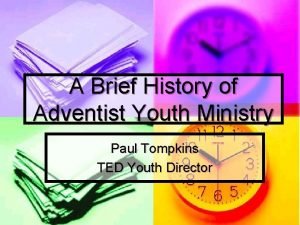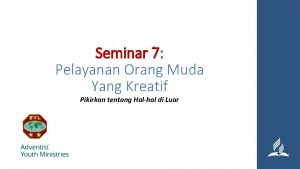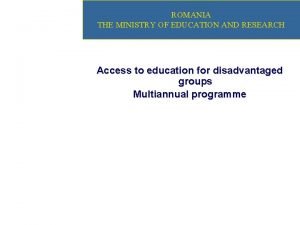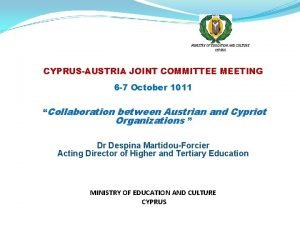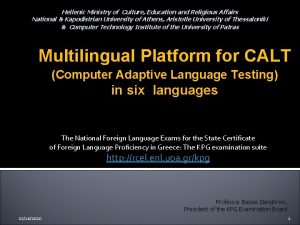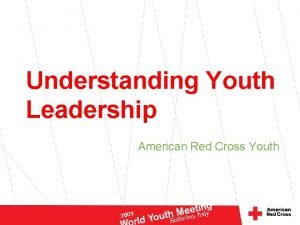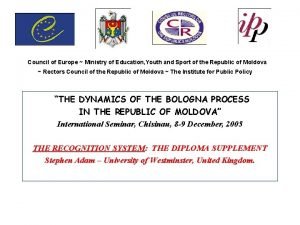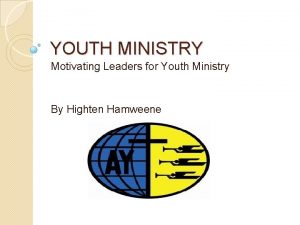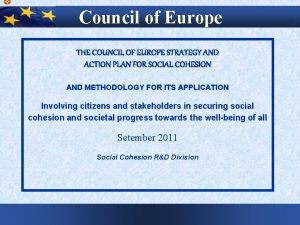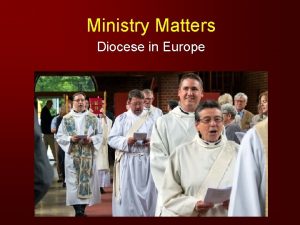Council of Europe Ministry of Education Youth and














- Slides: 14

Council of Europe ~ Ministry of Education, Youth and Sport of the Republic of Moldova ~ Rectors Council of the Republic of Moldova ~ The Institute for Public Policy “THE DYNAMICS OF THE BOLOGNA PROCESS IN THE REPUBLIC OF MOLDOVA” International Seminar, Chisinau, 8 -9 December, 2005 THE RECOGNITION SYSTYEM: THE EUROPEAN CREDIT TRANSFER AND ACCUMULATION SYSTEM Stephen Adam – University of Westminster, United Kingdom. 1

THE EUROPEAN CREDIT TRANSFER AND ACCUMULATION SYSTEM 1. What is a credit system? 2. What is ECTS? 3. How did ECTS emerge? 4. Why introduce ECTS? 5. What are the key features of ECTS? - 60 credits per academic year Learning outcomes, workload and credits Credit allocation Grade translation - Information package/course catalogue Learning agreement Transcript of record 6. What are the key documents of ECTS? 7. Concluding thoughts… 2

1. What is a credit system? q q A credit system is a systematic way of describing an educational programme by attaching credits to its components. They are designed to increase flexibility. Credits are commonly defined as a means of quantifying and recognising learning in terms of the achievement of learning outcomes and workload. Credit systems exist at local regional, national and international levels. 3

2. What is ECTS? The European Credit Transfer and Accumulation System is a student-centred system based on the student workload required to achieve the objectives of a programme, objectives preferably specified in terms of the learning outcomes and competences to be acquired. 4

3. How did ECTS develop? ECTS was introduced in 1989, within the framework of Erasmus, now part of the Socrates programme. ECTS is the only credit system which has been successfully tested and used across Europe. ECTS was set up initially for credit transfer. The system facilitated the recognition of periods of study abroad and thus enhanced the quality and volume of student mobility in Europe. Recently ECTS is developing into an accumulation system to be implemented at institutional, regional, national and European level. This is one of the key objectives of the Bologna Declaration of June 1999. 5

4. Why introduce ECTS? ECTS makes study programmes easy to read and compare for all students, local and foreign. ECTS facilitates mobility and academic recognition. ECTS helps universities to organise and revise their study programmes. ECTS can be used across a variety of programmes and modes of delivery. ECTS makes European higher education more attractive for students from abroad. 6

5. What are the key features of ECTS? 60 Credits per academic year: q ECTS is based on the principle that 60 credits measure the workload and learning outcomes of a full-time student during one academic year. The student workload of a full-time study programme in Europe amounts in most cases to around 15001800 hours per year and in those cases one credit stands for around 25 to 30 working hours. 7

5. What are the key features of ECTS? Learning outcomes, workload, credits: q. Credits in ECTS can only be obtained after successful completion of the work required and appropriate assessment of the learning outcomes achieved. q. Learning outcomes are sets of competences, expressing what the student will know, understand or be able to do after completion of a process of learning, long or short. q. Student workload in ECTS consists of the time required to complete all planned learning activities such as attending lectures, seminars, independent and private study, preparation of projects and examinations. 8

5. What are the key features of ECTS? Credit allocation: q. Credits are allocated to all educational components of a study programme (such as modules, courses, placements, dissertation work, ) and reflect the quantity of work each component requires to achieve its specific objectives or learning outcomes in relation to the total quantity of work necessary to complete a full year of study successfully. 9

5. What are the key features of ECTS? Grade translation: q. The performance of the student is documented by a local/national grade. It is good practice to add an ECTS grade, in particular in case of credit transfer. The ECTS grading scale ranks the students on a statistical basis. Grades are assigned among students with a pass grade as follows: A best 10% B next 25% C next 30% D next 25% E next 10% q. A distinction is made between the grades FX and F that are used for unsuccessful students. FX means: “fail- some more work required to pass” and F means: “fail – considerable further work required”. 10

6. What are the key documents of ECTS? Information package/course catalogue: q. The regular Information Package/Course Catalogue of the institution to be published in the local/national language and in English (or only in English for programmes taught in English) on the Web and/or in hard copy in one or more booklets. The Information Package/Course Catalogue must contain the items of the checklist including information for host students from abroad. 11

6. What are the key documents of ECTS? Learning agreement: q. The Learning Agreement contains the list of courses to be taken with the ECTS credits which will be awarded for each course. This list must be agreed by the student and the responsible academic body of the institution concerned. In the case of credit transfer, the Learning Agreement has to be agreed by the student and the two institutions concerned before the student’s departure and updated immediately when changes occur. 12

6. What are the key documents of ECTS? Transcript of records: q. The Transcript of Records documents the performance of a student by showing the list of courses taken, the ECTS credits gained, local or national credits, if any, local grades and possibly ECTS grades awarded. In the case of credit transfer, the Transcript of Records has to be issued by the home institution for outgoing students before departure and by the host institution for incoming students at the end of their period of study. 13

Concluding thoughts… q. The relationship between ECTS and the EQF and national qualifications frameworks and the Bologna overarching qualifications framework is not fully clarified. However, the Commission is currently seeking to develop a unified approach to credit for lifelong learning. q. The ECTS transfer and accumulations functions are distinct. The existing EC guidance on this is not particularly helpful. q. The detailed rules and procedures for credit systems are made at national, regional and local levels. ECTS is a meta level system. q. Further information source: European Commission DG for Education, Training and Culture http: //europa. eu. int/comm/education/programmes/socrates/ects/index_en. html 14
 Ministry of youth and sports cambodia
Ministry of youth and sports cambodia Kevin bohli
Kevin bohli Kalakbay youth ministry
Kalakbay youth ministry Background adventist youth
Background adventist youth Youth ministry structure
Youth ministry structure Pemuda gereja yang kreatif
Pemuda gereja yang kreatif Prayer for youth leaders
Prayer for youth leaders Ministry of education romania
Ministry of education romania Ministry of education and culture cyprus
Ministry of education and culture cyprus Hellenic ministry of education and religious affairs
Hellenic ministry of education and religious affairs Ministry of education and research romania
Ministry of education and research romania Ministry of education and science of the russian federation
Ministry of education and science of the russian federation Seo for youth sports clubs
Seo for youth sports clubs Adventist youth council members
Adventist youth council members Red cross youth
Red cross youth



